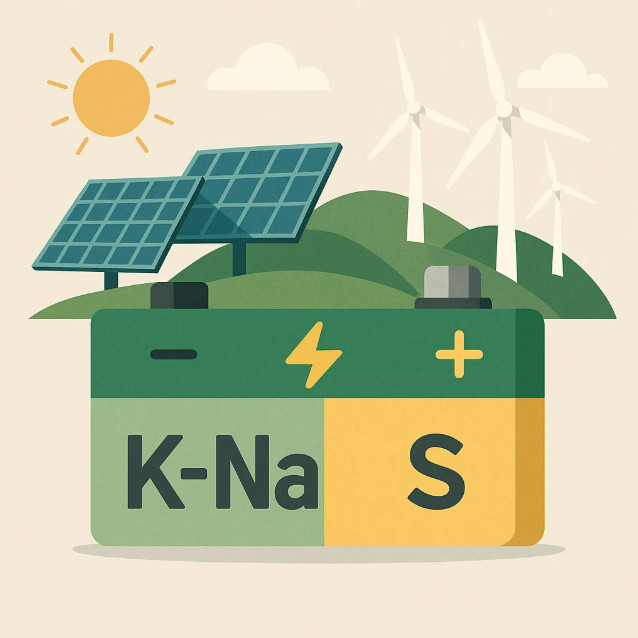м№јлҘЁ-лӮҳнҠёлҘЁ/нҷ© кё°л°ҳ м Җ비мҡ© л°°н„°лҰ¬: мһ¬мғқм—җл„Ҳм§Җ м ҖмһҘмқҳ мғҲлЎңмҡҙ м—ҙмҮ
лҰ¬нҠ¬мқ„ л„ҳм–ҙм„ңлҠ” м°Ём„ёлҢҖ лҢҖм•Ҳ
м„ёкі„ м—җл„Ҳм§Җ м „нҷҳмқҳ мӨ‘мӢ¬м—җлҠ” вҖҳм ҖмһҘ(Storage)вҖҷмқҙлқјлҠ” кіјм ңк°Җ мһҲлӢӨ. нғңм–‘кҙ‘кіј н’Қл ҘмқҖ л¬ҙн•ңн•ҳм§Җл§Ң, н•ҙк°Җ м§Җкұ°лӮҳ л°”лһҢмқҙ л©Һмңјл©ҙ м „л Ҙмқҙ лҒҠкё°лҠ” вҖҳк°„н—җм„ұвҖҷмқҙ мЎҙмһ¬н•ңлӢӨ. м§ҖкёҲк№Ңм§ҖлҠ” лҰ¬нҠ¬мқҙмҳЁ л°°н„°лҰ¬к°Җ мқҙлҘј л©”мӣ м§Җл§Ң, лҶ’мқҖ 비мҡ©кіј мһҗмӣҗ м ңм•Ҫ, нҷ”мһ¬ мң„н—ҳм„ұмңјлЎң мһҘкё° лҢҖмҡ©лҹү м ҖмһҘм—җлҠ” н•ңкі„к°Җ мһҲм—ҲлӢӨ. л°”лЎң мқҙ нӢҲмғҲм—җм„ң л“ұмһҘн•ң кІғмқҙ м№јлҘЁ-лӮҳнҠёлҘЁ/нҷ©(K-Na/S) л°°н„°лҰ¬лӢӨ.
2025л…„, 컬лҹјл№„м•„ лҢҖн•ҷ м—°кө¬нҢҖмқҖ 'Nature Communications'м—җ м№јлҘЁ-лӮҳнҠёлҘЁ/нҷ© кё°л°ҳ л°°н„°лҰ¬мқҳ мӢӨн—ҳм Ғ м„ұкіјлҘј л°ңн‘ңн–ҲлӢӨ. мқҙ л°°н„°лҰ¬лҠ” лҰ¬нҠ¬мқҙ м•„лӢҢ м№јлҘЁкіј лӮҳнҠёлҘЁ к°ҷмқҖ н’Қл¶Җн•ҳкі к°’мӢј мӣҗмҶҢлҘј нҷңмҡ©н•ҳкі , кі л№„мҡ© нқ¬мҶҢ кёҲмҶҚ лҢҖмӢ нҷ©мқ„ нҷңмҡ©н•ЁмңјлЎңмҚЁ 'м Җ비мҡ©В·кі нҡЁмңЁВ·м•Ҳм „м„ұ'мқ„ лҸҷмӢңм—җ 충мЎұн• мҲҳ мһҲлҠ” к°ҖлҠҘм„ұмқ„ м—ҙм—ҲлӢӨ.
мӨ‘мҳЁм—җм„ңмқҳ м•Ҳм •м Ғ мһ‘лҸҷмқҙлқјлҠ” лҸҢнҢҢкө¬
кё°мЎҙмқҳ лӮҳнҠёлҘЁ-нҷ©(Na-S) л°°н„°лҰ¬лҠ” 300В°C мқҙмғҒ кі мҳЁм—җм„ңл§Ң мһ‘лҸҷн•ҙ мӮ°м—…м Ғ нҷңмҡ©м—җ м ңм•Ҫмқҙ м»ёлӢӨ. к·ёлҹ¬лӮҳ мқҙлІҲ м—°кө¬нҢҖмқҖ м „н•ҙм§Ҳмқҳ нҳҒмӢ м Ғ м„Өкі„ лҚ•л¶„м—җ 'м•Ҫ 75В°CлқјлҠ” мӨ‘мҳЁ нҷҳкІҪм—җм„ңлҸ„ м•Ҳм •м Ғ мһ‘лҸҷ'мқ„ мӢӨнҳ„н–ҲлӢӨ.
н•өмӢ¬мқҖ мғҲлЎңмҡҙ м „н•ҙм§Ҳ мЎ°н•©мқҙлӢӨ. м—°кө¬м§„мқҖ K-Na н•©кёҲ мқҢк·№кіј нҷ© м–‘к·№ мӮ¬мқҙм—җм„ң м „н•ҙм§Ҳмқҙ нҡЁмңЁм ҒмңјлЎң мқҙмҳЁмқ„ м „лӢ¬н•ҳлҸ„лЎқ мөңм Ғнҷ”н–Ҳмңјл©°, кі мҳЁмқҙ м•„лӢҲм–ҙлҸ„ мқҙмҳЁ м „лҸ„м„ұмқ„ мң м§Җн• мҲҳ мһҲкІҢ м„Өкі„н–ҲлӢӨ. мқҙ лҚ•л¶„м—җ м—җл„Ҳм§Җ нҡЁмңЁмқҙ лҶ’м•„м§Җкі , кё°мЎҙ кі мҳЁнҳ• Na-S л°°н„°лҰ¬м—җм„ң л°ңмғқн•ҳлҚҳ л¶ҖмӢқкіј кө¬мЎ°м Ғ м—ҙнҷ” л¬ём ңлҸ„ нҒ¬кІҢ мӨ„м–ҙл“Өм—ҲлӢӨ.
мӨ‘мҳЁ мһ‘лҸҷмқҖ лӢЁмҲңнһҲ м—җл„Ҳм§Җ нҡЁмңЁ к°ңм„ л§Ңмқҙ м•„лӢҲлӢӨ. мӢңмҠӨн…ң мң м§Җ 비мҡ©кіј м•Ҳм „м„ұк№Ңм§Җ нҡҚкё°м ҒмңјлЎң лҒҢм–ҙмҳ¬лҰ°лӢӨ. мқҙлҠ” кі§, вҖҳмӢӨн—ҳмӢӨ лӢЁкі„мқҳ к°ҖлҠҘм„ұвҖҷм—җм„ң вҖҳмғҒмҡ©нҷ”лЎң к°ҖлҠ” нҳ„мӢӨм Ғ кІҪлЎңвҖҷлЎңмқҳ лҸ„м•Ҫмқ„ мқҳлҜён•ңлӢӨ.
м Җ비мҡ©В·кі нҡЁмңЁмқҳ мӮјл°•мһҗ
м№јлҘЁкіј лӮҳнҠёлҘЁмқҖ м§Җк°Ғм—җ н’Қл¶Җн•ҳкі м Җл ҙн•ҳлӢӨ. лҰ¬нҠ¬, мҪ”л°ңнҠё, лӢҲмјҲмІҳлҹј кіөкёүл§қмқҙ м ңн•ңм Ғмқҙм§Җ м•Ҡмңјл©°, м§Җм •н•ҷм Ғ лҰ¬мҠӨнҒ¬м—җлҸ„ лҚң м·Ём•Ҫн•ҳлӢӨ. м—¬кё°м—җ нҷ©мқҖ м„қмң нҷ”н•ҷ мӮ°м—…м—җм„ң л¶ҖмӮ°л¬јлЎң лҢҖлҹү л°ңмғқн•ҳлҠ” к°’мӢј мһҗмӣҗмқҙлӢӨ.
л”°лқјм„ң K-Na/S л°°н„°лҰ¬лҠ” мҶҢмһ¬ мӣҗк°Җл§Ң лҶ“кі ліҙлҚ”лқјлҸ„ лҰ¬нҠ¬мқҙмҳЁ л°°н„°лҰ¬ лҢҖ비 мҲҳмӢӯ нҚјм„јнҠё лӮ®м¶ң мҲҳ мһҲлӢӨ. мӢӨн—ҳм—җм„ңлҠ” кё°мЎҙ Na-S л°°н„°лҰ¬ лҢҖ비 лҚ” лӮ®мқҖ мҳЁлҸ„м—җм„ң лҶ’мқҖ м—җл„Ҳм§Җ нҡЁмңЁмқ„ кё°лЎқн–Ҳмңјл©°, мҲҳлӘ… мёЎл©ҙм—җм„ңлҸ„ м•Ҳм •м Ғ м¶©л°©м „мқҙ к°ҖлҠҘн•Ёмқҙ мһ…мҰқлҗҳм—ҲлӢӨ.
мқҙлҹ¬н•ң нҠ№м„ұмқҖ мһ¬мғқм—җл„Ҳм§Җ мһҘкё° м ҖмһҘ(Seasonal Storage)м—җ мөңм Ғнҷ”лҗң н•ҙлІ•мңјлЎң м—°кІ°лҗңлӢӨ. мҳҲлҘј л“Өм–ҙ, м—¬лҰ„мІ нғңм–‘кҙ‘мңјлЎң лӮЁлҠ” м „л Ҙмқ„ K-Na/S л°°н„°лҰ¬м—җ м ҖмһҘн•ҙл‘җкі , кІЁмҡёмІ лӮңл°© мҲҳмҡ”к°Җ лӘ°лҰ¬лҠ” мӢңкё°м—җ кәјлӮҙ м“°лҠ” л°©мӢқмқҙ к°ҖлҠҘн•ҙ진лӢӨ.
м—җл„Ҳм§Җ мӮ°м—…кіј нҷҳкІҪм—җ лҜём№ҳлҠ” мқҳлҜё
мқҙ кё°мҲ мқҙ мЈјлҠ” нҢҢкёүл ҘмқҖ лӢЁмҲңнһҲ вҖҳк°’мӢј л°°н„°лҰ¬вҖҷ мқҙмғҒмқҙлӢӨ.
мІ«м§ё, 'мһ¬мғқм—җл„Ҳм§Җ нҷ•лҢҖмқҳ лі‘лӘ© н•ҙмҶҢ'лӢӨ. н’Қл ҘВ·нғңм–‘кҙ‘ л°ңм „мҶҢлҠ” лӮ®кіј л°Ө, кі„м Ҳлі„ нҺём°Ёк°Җ мӢ¬н•ҳлӢӨ. мқҙлҘј м•Ҳм •м ҒмңјлЎң кіөкёүл§қм—җ м—°кІ°н•ҳл Өл©ҙ мһҘкё° м ҖмһҘ мһҘм№ҳк°Җ н•„мҲҳм ҒмқҙлӢӨ. K-Na/S л°°н„°лҰ¬лҠ” лҰ¬нҠ¬ кё°л°ҳ ESS(м—җл„Ҳм§Җ м ҖмһҘ мӢңмҠӨн…ң)мқҳ 비мҡ© мһҘлІҪмқ„ л¬ҙл„ҲлңЁлҰҙ мҲҳ мһҲлӢӨ.
л‘ҳм§ё, 'м§ҖмҶҚ к°ҖлҠҘм„ұмқҳ к°•нҷ”'лӢӨ. нқ¬мҶҢ кёҲмҶҚ мқҳмЎҙмқ„ мӨ„мқҙкі , н’Қл¶Җн•ң мһҗмӣҗмқ„ нҷңмҡ©н•ҳлҠ” мқҙ кё°мҲ мқҖ мһҗмӣҗ мұ„көҙлЎң мқён•ң нҷҳкІҪ нҢҢкҙҙлҘј нҒ¬кІҢ мӨ„мқёлӢӨ. нҷ©кіј к°ҷмқҖ л¶ҖмӮ°л¬јмқ„ нҷңмҡ©н•ңлӢӨлҠ” м җлҸ„ мҲңнҷҳ кІҪм ңм Ғ к°Җм№ҳк°Җ нҒ¬лӢӨ.
м…Ӣм§ё, 'мӮ°м—… кө¬мЎ° мһ¬нҺё'мқҙлӢӨ. л§Ңм•Ҫ K-Na/S л°°н„°лҰ¬к°Җ мғҒмҡ©нҷ”лҗңлӢӨл©ҙ, нҳ„мһ¬ лҰ¬нҠ¬м—җ 집мӨ‘лҗң кіөкёүл§қкіј кё°м—… кө¬мЎ°к°Җ нқ”л“ӨлҰҙ мҲҳ мһҲлӢӨ. л°°н„°лҰ¬ м ңмЎ°мӮ¬мҷҖ л°ңм „мӮ¬лҠ” мғҲлЎңмҡҙ мӣҗмһҗмһ¬В·мӢ к·ң м„Ө비 нҲ¬мһҗлҘј нҶөн•ҙ кІҪмҹҒ кө¬лҸ„лҘј мһ¬нҺён•ҳкІҢ лҗ кІғмқҙлӢӨ.
мғҒмҡ©нҷ”лҘј н–Ҙн•ң кіјм ңл“Ө
к·ёлҹ¬лӮҳ л„ҳм–ҙм•ј н• лӮңкҙҖлҸ„ 분лӘ…н•ҳлӢӨ.
мІ«м§ё, 'мӢӨмҰқ к·ңлӘЁ нҷ•лҢҖ'лӢӨ. м§ҖкёҲк№Ңм§ҖлҠ” м—°кө¬мӢӨкіј нҢҢмқјлҹҝ лӢЁкі„м—җм„ң кІҖмҰқлҗң мҲҳмӨҖмқҙлӢӨ. мҲҳл°ұ kWh\~MWh к·ңлӘЁлЎң нҷ•лҢҖн–Ҳмқ„ л•Ң лҸҷмқјн•ң м„ұлҠҘмқ„ лӮј мҲҳ мһҲлҠ”м§Җ 추к°Җ кІҖмҰқмқҙ н•„мҡ”н•ҳлӢӨ.
л‘ҳм§ё, 'мҲҳлӘ…кіј м•Ҳм •м„ұ'мқҙлӢӨ. мӨ‘мҳЁ мһ‘лҸҷмқҙ к°ҖлҠҘн•ҙмЎҢлӢӨкі н•ҙлҸ„ мҲҳл§Ң нҡҢ м¶©л°©м „мқҙ н•„мҡ”н•ң мһҘкё° ESS мЎ°кұҙм—җм„ң м–јл§ҲлӮҳ кІ¬л”ң мҲҳ мһҲмқ„м§ҖлҠ” м•„м§Ғ м—°кө¬к°Җ н•„мҡ”н•ҳлӢӨ.
м…Ӣм§ё, '비мҡ© кө¬мЎ°'лӢӨ. мӣҗмһҗмһ¬ мһҗмІҙлҠ” м Җл ҙн•ҳм§Җл§Ң, мғҲлЎңмҡҙ м „н•ҙм§Ҳ н•©м„ұ кіөм •кіј мӢңмҠӨн…ң м„Өкі„м—җм„ң мҙҲкё° 비мҡ©мқҙ л°ңмғқн•ңлӢӨ. лҳҗн•ң л°°н„°лҰ¬ нҢ©кіј кҙҖлҰ¬ мӢңмҠӨн…ң(BMS)мқҳ мөңм Ғнҷ”лҸ„ н•„мҲҳм ҒмқҙлӢӨ.
л„·м§ё, 'м•Ҳм „м„ұ л°Ҹ к·ңм ң'лӢӨ. мһҘмЈјкё° м ҖмһҘмһҘм№ҳк°Җ мғҒм—…мҡ©мңјлЎң м“°мқҙл Өл©ҙ көӯм ң м•Ҳм „ мқёмҰқкіј к·ңм ң кё°мӨҖмқ„ нҶөкіјн•ҙм•ј н•ңлӢӨ. мқҙлҠ” лӢЁмҲңн•ң мӢӨн—ҳм Ғ м„ұкіјлҘј л„ҳм–ҙ мғҒм—…м Ғ мӢ лў°м„ұмқ„ нҷ•ліҙн•ҳлҠ” лҚ° мӨ‘мҡ”н•ң мһҘлІҪмқҙлӢӨ.
л°°н„°лҰ¬лҘј лӢӨмӢң к·ёлҰ¬лӢӨ
мқҙлІҲ м—°кө¬мқҳ мқҳмқҳлҠ” л°°н„°лҰ¬лҘј вҖҳлҚ” мӢёкі мҳӨлһҳ м“°лҠ” мһҘм№ҳвҖҷ к·ё мқҙмғҒмңјлЎң мһ¬м •мқҳн•ңлӢӨлҠ” м җм—җ мһҲлӢӨ. н’Қл¶Җн•ң мһҗмӣҗкіј к°„лӢЁн•ң нҷ”н•ҷ кө¬мЎ°лҘј кё°л°ҳмңјлЎң, лҰ¬нҠ¬ мӨ‘мӢ¬мқҳ нҢЁлҹ¬лӢӨмһ„мқ„ л„ҳм–ҙм„ңлҠ” 'мғҲлЎңмҡҙ м—җл„Ҳм§Җ м ҖмһҘ мғқнғңкі„'лҘј м—ҙкі мһҲлҠ” кІғмқҙлӢӨ.
мқҙлҠ” л§Ҳм№ҳ, 값비мӢј нқ¬к·Җ м•Ҫн’Ҳм—җ мқҳмЎҙн•ҳлҚҳ мқҳлЈҢ мІҙкі„к°Җ ліҙнҺём Ғмқҙкі м Җл ҙн•ң лҢҖмІҙм ңлҘј м°ҫм•„лӮҙ лӘЁл‘җм—җкІҢ нҳңнғқмқ„ мЈјлҠ” кІғкіј к°ҷлӢӨ. K-Na/S л°°н„°лҰ¬лҠ” л°”лЎң к·ёлҹ° вҖҳліҙкёүнҳ• мҶ”лЈЁм…ҳвҖҷмңјлЎңм„ң, мһ¬мғқм—җл„Ҳм§Җ мӢңлҢҖлҘј кІ¬мқён• мҲҳ мһҲлҠ” кё°мҲ мқҙлӢӨ.
мһ¬мғқм—җл„Ҳм§Җ 100% мӢңлҢҖлҘј н–Ҙн•ң м—¬м •м—җм„ң, к°ҖмһҘ нҒ° мһҘм• л¬јмқҖ вҖҳм–ём ңлӮҳ м“ё мҲҳ мһҲлҠ” м „кё°вҖҷмҳҖлӢӨ. K-Na/S л°°н„°лҰ¬лҠ” мқҙ лӮңм ңлҘј н’Җ мӢӨл§ҲлҰ¬лҘј м ңмӢңн•ңлӢӨ. м•„м§Ғ мӢӨн—ҳмӢӨ лӢЁкі„лҘј лІ—м–ҙлӮҳм•ј н•ҳлҠ” кіјм ңк°Җ лӮЁм•ҳм§Җл§Ң, 'м Җ비мҡ©В·кі нҡЁмңЁВ·м§ҖмҶҚк°ҖлҠҘм„ұ'мқҙлқјлҠ” м„ё к°Җм§Җ мЎ°кұҙмқ„ лӘЁл‘җ 충мЎұн• мһ мһ¬л Ҙмқ„ ліҙм—¬мЈјм—ҲлӢӨлҠ” м җм—җм„ң, мқҙлІҲ м—°кө¬лҠ” мӨ‘мҡ”н•ң мқҙм •н‘ңлӢӨ.
м•һмңјлЎң 10л…„, K-Na/S л°°н„°лҰ¬к°Җ мӢӨмҡ©нҷ”лҗңлӢӨл©ҙ мҡ°лҰ¬лҠ” кі„м Ҳмқ„ мҙҲмӣ”н•ҙ м „кё°лҘј м ҖмһҘн•ҳкі м“°лҠ” мӢңлҢҖ, мҰү вҖҳм§„м •н•ң мһ¬мғқм—җл„Ҳм§Җ мӮ¬нҡҢвҖҷлҘј л§һмқҙн•ҳкІҢ лҗ кІғмқҙлӢӨ.
* Reference
Nature Communications, 2025, вҖңIntermediate-temperature K-Na/S battery with stable performance enabled by new electrolyte design", Columbia University Engineering
Potassium-Sodium/Sulfur-Based Low-Cost Battery: A New Key to Renewable Energy Storage
Beyond Lithium: The Next Alternative
At the center of the global energy transition lies a critical challenge: 'storage'. Solar and wind power are infinite, yet they suffer from the intermittency of the sun setting and the wind dying down. Until now, lithium-ion batteries have filled this gap, but their high cost, resource constraints, and fire risks limit their use in long-duration, large-scale storage. This is precisely the gap where potassium-sodium/sulfur (K-Na/S) batteries are emerging.
In 2025, a research team at Columbia University published experimental results on K-Na/S batteries in 'Nature Communications'. By using abundant, low-cost elements like potassium and sodium instead of lithium, and sulfur instead of expensive rare metals, this battery demonstrated the possibility of simultaneously achieving 'low cost, high efficiency, and safety'.
A Breakthrough in Stable Operation at Intermediate Temperatures
Conventional sodium-sulfur (Na-S) batteries only operate at very high temperatures—above 300В°C—which posed major industrial limitations. However, thanks to innovative electrolyte design, this research team achieved 'stable operation at around 75В°C, an intermediate temperature'.
The core lies in a new electrolyte combination. The researchers optimized the electrolyte to efficiently transfer ions between the K-Na alloy anode and the sulfur cathode, while maintaining ionic conductivity even at lower temperatures. This improved energy efficiency and significantly reduced corrosion and structural degradation that plagued conventional high-temperature Na-S batteries.
Operating at intermediate temperatures is not just about improved efficiency. It also drastically reduces system maintenance costs and enhances safety. In other words, this represents a leap from 'вҖңlaboratory-stage possibilityвҖқ to a вҖңrealistic pathway toward commercialization.вҖқ'
The Triple Advantage: Low Cost, High Efficiency, Sustainability
Potassium and sodium are abundant and inexpensive in the EarthвҖҷs crust. Unlike lithium, cobalt, and nickel, their supply chains are not restricted, nor are they highly vulnerable to geopolitical risks. In addition, sulfur is an extremely cheap byproduct of the petrochemical industry.
Thus, even in terms of raw material costs alone, K-Na/S batteries can be produced at significantly lower prices than lithium-ion batteries. Experiments showed higher energy efficiency at lower operating temperatures compared to existing Na-S batteries, along with stable charge-discharge cycles.
These characteristics make K-Na/S batteries an ideal solution for 'long-duration renewable energy storage (seasonal storage)'. For instance, surplus electricity from summer solar power could be stored in K-Na/S batteries and released during winter, when heating demand surges.
Implications for the Energy Industry and the Environment
The impact of this technology goes far beyond simply creating вҖңcheaper batteries.вҖқ
First, it 'removes bottlenecks to renewable energy expansion'. Wind and solar power plants suffer from sharp daily and seasonal fluctuations. To integrate them stably into the grid, long-term storage devices are essential. K-Na/S batteries could dismantle the cost barriers of lithium-based ESS (energy storage systems).
Second, it 'strengthens sustainability'. By reducing dependence on scarce metals and using abundant resources, this technology significantly lowers environmental destruction caused by resource mining. The use of sulfur, a byproduct, also brings major value to the circular economy.
Third, it 'reshapes industrial structures'. If K-Na/S batteries are commercialized, todayвҖҷs lithium-centric supply chains and corporate structures will be disrupted. Battery manufacturers and energy companies will have to invest in new raw materials and facilities, reorganizing the competitive landscape.
Challenges Toward Commercialization
Nevertheless, several hurdles remain.
First, 'scaling up demonstrations'. So far, performance has been validated only at the laboratory and pilot scale. Further verification is needed to see if the same results hold at scales of hundreds of kWh to MWh.
Second, 'cycle life and durability'. Even with intermediate-temperature operation, it remains to be seen whether the batteries can withstand the tens of thousands of charge-discharge cycles required for long-duration ESS.
Third, 'cost structure'. While raw materials are cheap, new electrolyte synthesis processes and system designs bring initial costs. Optimizing battery packs and battery management systems (BMS) will also be critical.
Fourth, 'safety and regulation'. For long-duration storage devices to be used commercially, they must pass international safety certifications and regulatory standards. This barrier is as crucial as experimental success, since it secures commercial trust.
Redefining the Battery
The true significance of this research lies in redefining what a battery can be—'not just cheaper and longer-lasting, but a new ecosystem for energy storage' that goes beyond lithium.
It is like discovering an affordable, widely available alternative to expensive rare drugs, giving benefits to everyone. K-Na/S batteries represent precisely such a вҖңmass-access solution,вҖқ capable of driving the renewable energy era forward.
On the journey toward a 100% renewable energy era, the biggest obstacle has been the challenge of ensuring вҖңelectricity anytime.вҖқ K-Na/S batteries offer a clue to solving this riddle. While hurdles remain in moving beyond the laboratory, the technology has already demonstrated its potential to meet the three essential conditions of 'low cost, high efficiency, and sustainability'.
If K-Na/S batteries are commercialized within the next decade, humanity may enter an era where electricity can be stored and used across seasons—a 'truly renewable energy society'.
* Reference
Nature Communications, 2025, вҖңIntermediate-temperature K-Na/S battery with stable performance enabled by new electrolyte design", Columbia University Engineering







